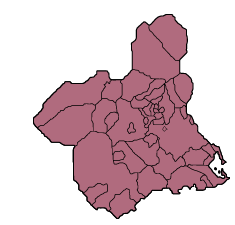Spain considers limiting vacation rental properties to 6-month licences
- Fri, 19.04.24 - 21:59


The government is consulting with industry representatives to curb the worrying rise of tourist apartments The Mi...
The government is consulting with industry representatives to curb the worrying rise of tourist apartments The Mi...
The first chiringuitos ready for business will be in Cabo Roig and Campoamor It seemed like it was never going to...
The victim has been identified as a Singapore tourist who was holidaying in Jávea, Alicante The Guardia Ci...
The deadly blaze in Tárbena has been raging for two days straight Firefighters in the Alicante town of T&a...
Alicante is enduring the worst drought in more than three decades with very little rain in sight With the worst d...
England and Barca manager Terry Venables passed away recently, but do you know how else he is linked to Spain? Fo...
Both the victim and the main suspect in the murder are thought to be foreigners The corpse of a woman was found i...
The 31-year-old was wanted in the United States for illegal proceeds totalling up to 30 million dollars A British...
Get help with menopause anywhere in Europe with The Women's Health Clinic In a bid to extend their reach and ...
The weekend ahead will be mostly dry with a few scattered showers in Alicante province Friday morning, April 19 ...
Classical brilliance on the Costa Blanca with Rachmaninov’s Swan Lake Immerse yourself in the magic of Tcha...
Works by the Yecla-born artist at the Casa Municipal de la Cultura in Yecla The evening of April 4 sees the opening o...
The event coincides with the first International Sports Tourism Week of Yecla Among the events being held in Yecla du...
Classical brilliance on the Costa Blanca with Rachmaninov’s Swan Lake Immerse yourself in the magic of Tcha...
Swing and traditional New Orleans music in a free concert in the Plaza de España in San Javier It is a privile...
The event coincides with the first International Sports Tourism Week of Yecla Among the events being held in Yecla du...
Classical brilliance on the Costa Blanca with Rachmaninov’s Swan Lake Immerse yourself in the magic of Tcha...
Nurses, physiotherapists and other nursing home employees wanted in Spain Caser Residencial, the nursing home and...
Nurses, physiotherapists and other nursing home employees wanted in Spain Caser Residencial, the nursing home and...
Nurses, physiotherapists and other nursing home employees wanted in Spain Caser Residencial, the nursing home and...
Find out how you can donate blood in Spain and if you’re eligible Blood donation is a vital contribution to...
It’s a widely held belief in Spain that water canisters will prevent pets from marking their territory In r...
Find out everything you need to know to visit Spain’s unique festival of fireworks and fun The Valencia Fal...
Go along to the Rawhiders clubhouse in Callosa de Segura for good food and friendly company The Costa Blanca Rawh...
Carwash, airport transfers and more without any cancellation fees from Lowcostparking.es If you need to park your...
DGT Spain has confirmed that new drivers will have to pass a course to ride 125cc motorbikes Spain's General ...
DGT Spain has confirmed that new drivers will have to pass a course to ride 125cc motorbikes Spain's General ...
DGT Spain has confirmed that new drivers will have to pass a course to ride 125cc motorbikes Spain's General ...
The government is consulting with industry representatives to curb the worrying rise of tourist apartments The Mi...
Sometimes it’s tempting to hire the first, cheapest or nearest handyman you find, but there are good reasons to sh...
Both the donor and the beneficiary will have to pay some taxes in Spain Until recently, donating real estate to a...
Yes, you can do your Spanish tax declaration online… but it’s not the easiest way Taxpayers in Spain...
Both the donor and the beneficiary will have to pay some taxes in Spain Until recently, donating real estate to a...
Here’s what you need to know about avoiding the pitfalls of black money in property transactions in Spain I...
Prepare your property for any weather with Leak Proof all-in-one waterproofing and UV-resistant surface Did you k...
What really is the need to get a Pre-Purchase Technical Inspection for your Costa Blanca property? Purchasing a p...
Prepare your property for any weather with Leak Proof all-in-one waterproofing and UV-resistant surface Did you k...
The government is consulting with industry representatives to curb the worrying rise of tourist apartments The Mi...
Prepare your property for any weather with Leak Proof all-in-one waterproofing and UV-resistant surface Did you k...
The government is consulting with industry representatives to curb the worrying rise of tourist apartments The Mi...
The weekend ahead will be mostly dry with a few scattered showers in Alicante province Friday morning, April 19 ...
The government is consulting with industry representatives to curb the worrying rise of tourist apartments The Mi...
The government is consulting with industry representatives to curb the worrying rise of tourist apartments The Mi...
The government is consulting with industry representatives to curb the worrying rise of tourist apartments The Mi...
Passengers can benefit from unlimited free train trips in Spain all summer with just a small deposit Spain’...
A Spanish court has decreed that LaLiga can fine viewers of pirate football, and not just the service providers LaLig...
An incoming DANA will bring rain to southern Spain and plummeting temperatures in most of the country Minimum and...
The 31-year-old was wanted in the United States for illegal proceeds totalling up to 30 million dollars A British...
